Post and Rail Fencing
What is post and rail fencing?
Post and rail fencing is a type of traditional fencing that consists of vertical posts connected by horizontal rails. It is a simple and rustic fencing style commonly used for agricultural, rural, and residential purposes. Post and rail fencing design allow for open spaces between the rails, providing a decorative boundary while still allowing visibility and maintaining an open feel.
Typically, post and rail fences are made from wooden materials, such as round or square timber posts and rails. The number of rails used can vary, but it typically ranges from two to four. The posts are set into the ground at regular intervals, and the rails are then attached horizontally between the posts.
Post and rail fencing is known for its durability, as the wooden posts are firmly set into the ground, providing stability and strength. This type of fencing is often used to enclose large areas such as pastures, fields, or gardens, giving a visible boundary without obstructing the view.
The open design of post and rail fencing makes it suitable for containing larger animals, such as horses or livestock, as they can easily see and navigate around the fence. It is also popular in residential areas where a rustic or country-style aesthetic is desired.
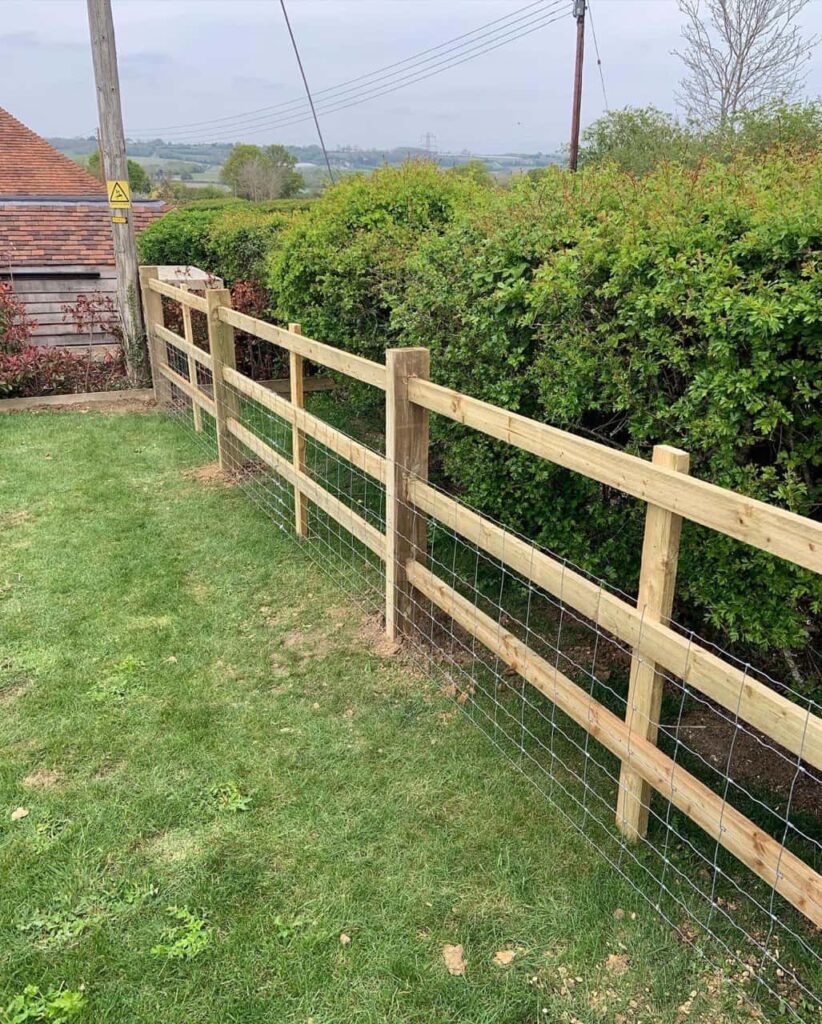
How long does post and rail fencing typically last?
The lifespan of post and rail fencing can vary depending on several factors, including the quality of materials, installation methods, maintenance, and exposure to weather conditions. However, post and rail fencing can last several decades when properly constructed and maintained.
Wooden post and rail fencing: The longevity of wooden post and rail fencing depends on the type of wood used and the level of maintenance. Generally, if the wood is of high quality and adequately treated or naturally resistant to decay, it can last 10 to 30 years or even longer. Regular maintenance, such as staining or painting every few years and ensuring the posts are securely set in the ground, can help prolong the fence’s lifespan.
Vinyl post and rail fencing: Vinyl post and rail fencing are known for their durability and resistance to rot, insects, and weathering. Vinyl fencing lasts 20 to 30 years or more when properly installed and maintained. It requires minimal maintenance, typically limited to occasional cleaning to remove dirt or debris.
Metal post and rail fencing: Metal post and rail fencing, such as steel or aluminium, is highly durable and can withstand harsh weather conditions. With proper installation and maintenance, metal fencing can last for 30 years or more. Regular inspections for signs of rust or corrosion and prompt repairs or treatments can help extend its lifespan.
It’s important to note that these are general estimates, and the actual lifespan of post and rail fencing can vary depending on the specific circumstances. Factors like exposure to extreme weather, soil conditions, and regular maintenance practices significantly determine how long the fence will last. Regular inspections and timely repairs or replacements of damaged or deteriorated components can help maximise the fence’s lifespan.
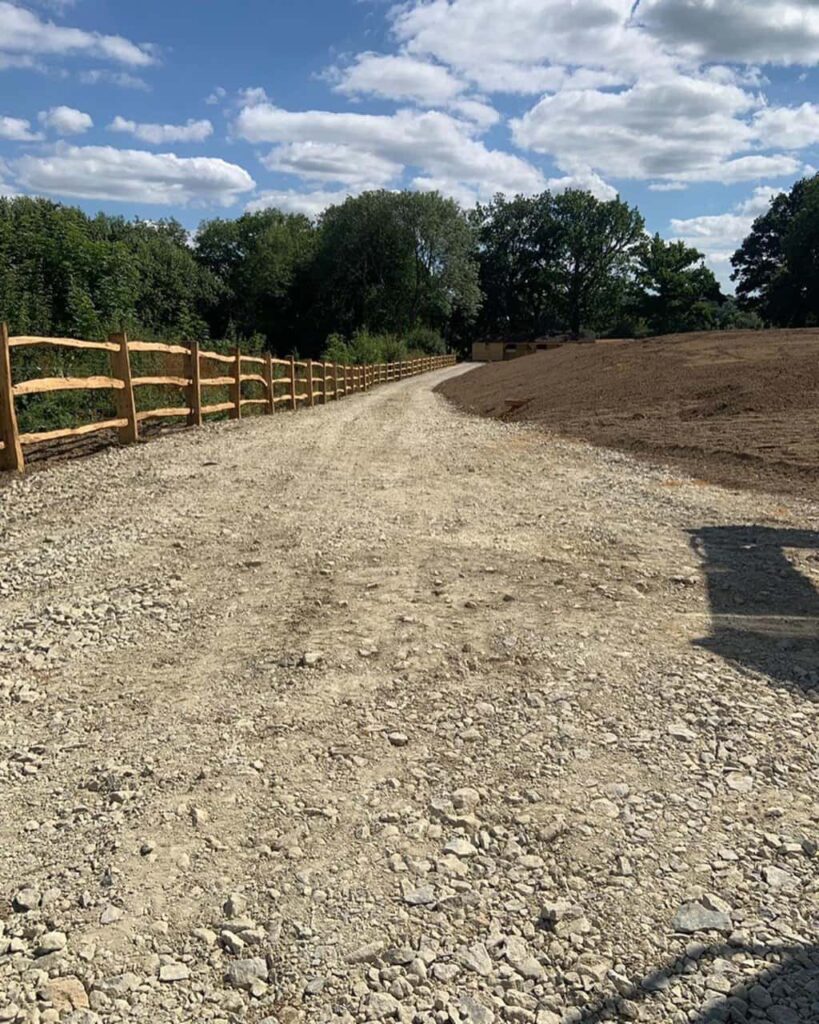
Can post and rail fencing be customised in terms of height and spacing?
Yes, post and rail fencing can be customised in terms of height and spacing to suit specific needs and preferences. The flexibility of post and rail fencing allows for adjustments to accommodate different requirements.
Height customisation: Post and rail fencing height can be modified based on the intended purpose and the type of animals or objects to be contained. For example, if the fencing is designed for horses or large livestock, a higher fence may be necessary to prevent them from jumping or leaning over the fence. On the other hand, for decorative or boundary purposes where containment is not the primary concern, a lower fence height may be sufficient. The number of rails used can also influence the overall height of the fence.
Spacing customisation: The spacing between the rails in post and rail fencing can also be customised. The number of rails used can vary depending on the desired appearance, level of containment, and functionality. More rails can provide a more solid appearance and increase containment, while fewer rails can create a more open and decorative look. The spacing between the rails can be adjusted accordingly.
It’s vital to ensure that the spacing and height of the fence comply with local regulations and any specific requirements for containing animals or meeting safety standards.
Customising the height and spacing of post and rail fencing can be tailored to meet specific needs, whether for aesthetic purposes, containing animals, or defining boundaries.
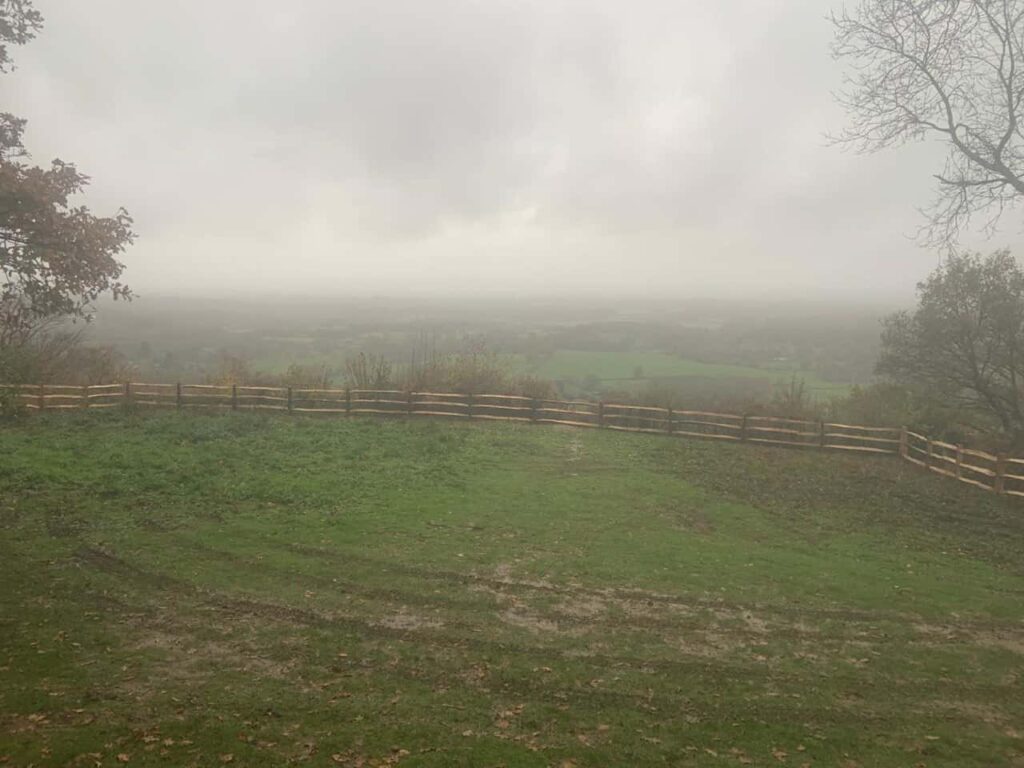
How are post and rail fencing installed?
Installing post and rail fencing generally involves the following steps:
Planning and Marking: Start by planning the fence layout and marking the locations where the posts will be installed. Use measuring tape, stakes, and string to establish straight lines and accurately mark the positions of the posts along the intended fence line.
Digging Post Holes: Dig holes for the posts using a post hole digger or an auger. The depth and diameter of the holes will depend on the specific requirements and the height of the fence. As a general guideline, the holes should be approximately one-third of the total length of the post and at least 2 feet deep. Space the holes according to the desired spacing between the posts.
Installing Posts: Place the posts in the holes, ensuring they are level and properly aligned. Backfill the holes with soil or gravel and firmly tamp it down to provide stability and support for the posts. Repeat this process for all the posts along the fence line.
Installing Rails: Attach the horizontal rails to the posts once the posts are securely in place. The rails can be nailed or screwed into the posts depending on the design. Ensure that the rails are evenly spaced and level. The number of rails used will depend on personal preference, the intended purpose of the fence, and the desired appearance.
Finishing Touches: Inspect the fence for any loose connections or gaps once the rails are securely attached. Make any necessary adjustments and ensure the fence is stable and secure. If desired, apply a protective finish, such as stain or paint, to the wooden components to enhance their durability and appearance.
It’s important to note that these steps provide a general overview of the post and rail fencing installation process. The specific installation techniques and requirements we use may vary based on factors such as the type of material used, and individual preferences. We will ensure all works carried out are suitable for your needs.
What are the benefits of post and rail fencing?
Post and rail fencing offers several benefits, including:
Visibility: The open post and rail fencing design allows for clear visibility inside and outside the fenced area. This can be advantageous for security, enabling property owners to see potential intruders or animals approaching the property.
Aesthetics: Post and rail fencing has a rustic and traditional look that can enhance the overall appearance of a property. It can create a charming and picturesque boundary, particularly in rural or countryside settings.
Cost-effective: Compared to other types of fencing, post and rail fencing can be cost-effective. The materials used, such as wooden posts and rails, are generally more affordable than other fencing materials like metal.
Easy installation: Post and rail fencing is relatively easy, especially compared to more complex fencing systems. The straightforward design and fewer components ensures it can be installed quickly and efficiently.
Durability: Post and rail fencing can be quite durable when properly constructed and maintained. When treated or naturally resistant to decay, the wooden posts can withstand the elements and last for many years. Regular maintenance, such as staining or painting, can help prolong the fence’s lifespan.
Versatility: Post and rail fencing can be adapted to various settings and purposes. They are commonly used for containing livestock, such as horses or cattle, but they can also be used as a decorative boundary for gardens or properties. The number of rails can be adjusted based on specific needs.
Environmentally friendly: If constructed using sustainably sourced wood, post, and rail fencing can be an environmentally friendly option. Wood is a renewable resource, and when the fence reaches the end of its lifespan, it can be recycled or decompose naturally.
Overall, post and rail fencing combines functionality with appealing aesthetics, making it a popular choice for those seeking a classic and practical fencing solution.

What are the typical applications for post and rail fencing?
Post and rail fencing are used for various applications in different settings. Some typical applications include:
Agricultural and Livestock Enclosures: Post and rail fencing is commonly used to enclose pastures, paddocks, and agricultural areas where livestock such as horses, cattle, or sheep are kept. The open post and rail fencing design allows animals to see their surroundings while providing a visible boundary and containment.
Rural Properties: Post and rail fencing is often seen on rural properties, and farms. It can define property boundaries, separate land areas, and create a charming aesthetic that blends with the countryside or natural surroundings.
Residential Fencing: Post and rail fencing can be used in residential settings, particularly rural areas, to enclose gardens, or properties. It can provide a decorative and visually appealing boundary without completely obstructing the view.
Parks and Recreational Areas: Post and rail fencing is sometimes used in parks, nature reserves, and recreational areas to designate boundaries or restrict access to specific areas while maintaining an open and natural feel.
Equestrian Facilities: Post and rail fencing is popular in equestrian settings, including horse farms, riding arenas, or training facilities. It provides a safe and visually appealing enclosure for horses, allowing them to see their surroundings and minimising the risk of injury.
Landscaping and Garden Edging: Post and rail fencing can be used in landscaping projects as a decorative element or to create garden edging. It can define the boundaries of flower beds, paths, or other landscaped areas while adding a rustic touch to the overall design.
Public Spaces: Post and rail fencing can be found in public spaces such as community parks, botanical gardens, or historic sites. It is often used to delineate specific areas, guide visitors, or provide a barrier while allowing unobstructed views.
These are just a few examples of typical post and rail fencing applications. The versatility, rustic charm, and functional design of this type of fencing make it suitable for a wide range of settings where a visible, open, and aesthetically pleasing boundary is desired.
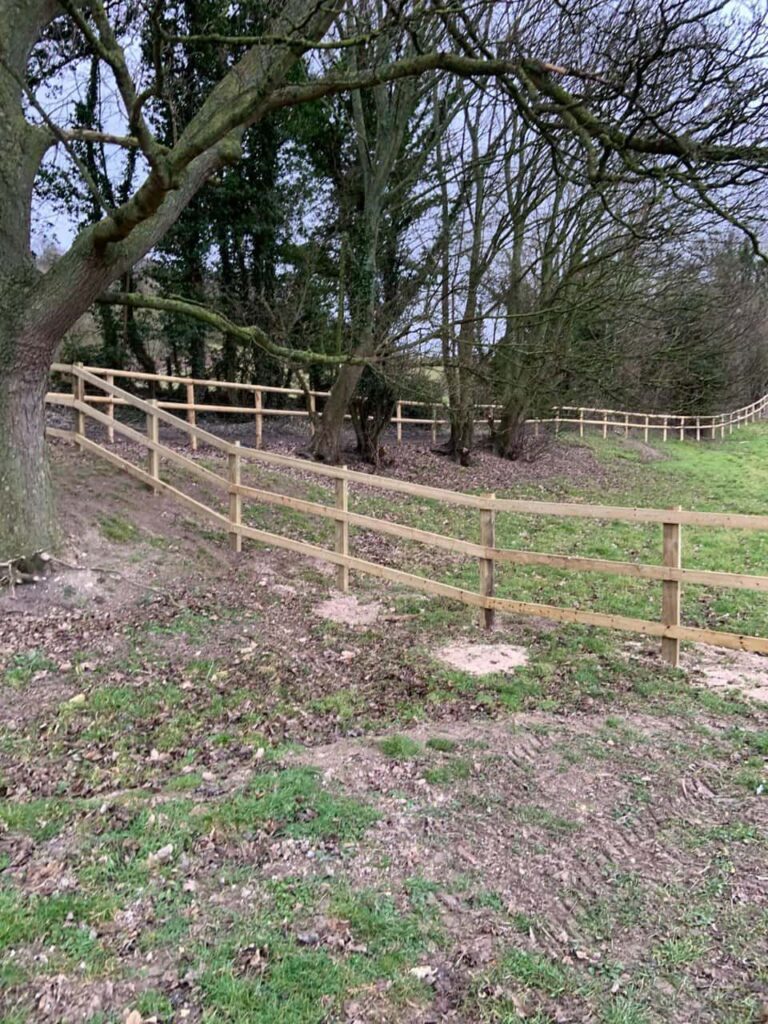
Are post and rail fencing suitable for containing animals or livestock?
Yes, post and rail fencing is commonly used for containing animals and livestock. It is a suitable fencing option for many types of animals, including horses, cattle, sheep, goats, and more. Here are a few reasons why post and rail fencing is often used for this purpose:
Visibility: The open post and rail fencing design allows animals to see their surroundings. This visibility can help reduce feelings of confinement and anxiety, as animals can observe their environment and have a clear line of sight beyond the fence.
Containment: Post and rail fencing, when properly constructed, provides a visible and sturdy barrier that helps contain animals within a designated area. The vertical posts and horizontal rails create a boundary that animals are less likely to breach compared to other fencing types.
Safety: Post and rail fencing is generally considered safer for animals than solid panel fences or fences with small openings. The open design reduces the risk of animals getting their heads, legs, or bodies caught between the rails, minimising the potential for injuries.
Durability: Depending on the type of wood used and proper maintenance, post, and rail fencing can be durable and withstand the wear and tear caused by animals. Treated or naturally resistant wood can offer increased resistance to decay and damage from animals’ grazing, rubbing, or chewing behaviours.
Easy Repairs: In the event of damage, post and rail fencing is relatively easy to repair. Individual rails or sections can be replaced without requiring extensive reconstruction, making addressing any damage caused by animals or other factors convenient.
It’s important to note that while post and rail fencing can effectively contain many types of animals, the suitability may vary depending on the specific animal species, their behaviours, and specific containment requirements. It’s advisable to consider animal size, strength, jumping abilities, and particular needs when selecting and configuring the fence for animal containment.

Can post and rail fencing be painted or stained?
Yes, post and rail fencing can be painted or stained to enhance their appearance, protect the wood, and increase their longevity. Painting or staining the fence allows you to customise its colour and style to match your preferences or the surrounding environment. Here are some considerations for painting or staining post and rail fencing:
Preparation: Before applying paint or stain, ensure that the fence’s surface is clean and free from dirt, debris, and any previous coatings. Use a brush or pressure washer to remove any build-up or loose material if necessary. Allow the fence to dry thoroughly before proceeding.
Choosing the Right Product: Select a paint or stain product suitable for exterior use and designed for wood surfaces. Consider the specific characteristics of the wood used in your fence and choose a product that provides the desired level of protection and durability.
Application: Follow the manufacturer’s instructions for applying paint or stain. Use a brush, roller, or sprayer, depending on the product and the size of the fence. Apply an even coat, working in the direction of the wood grain. Ensure that the product is applied uniformly to achieve a consistent finish.
Multiple Coats: Depending on the desired colour and coverage, multiple coats may be necessary. Allow each coat to dry according to the manufacturer’s instructions before applying additional coats. Be mindful of any recommended waiting times or curing periods between coats.
Maintenance: Over time, the painted or stained surface of the fence may become weathered or show signs of wear. Regularly inspect the fence and touch up or reapply paint or stain as needed. Follow the manufacturer’s recommendations for maintenance, such as cleaning and reapplication intervals.
It’s advisable to test the paint or stain on a small, inconspicuous area of the fence first to ensure the desired result before applying it to the entire fence.
Properly painting or staining post and rail fencing can enhance its aesthetics, protect the wood from the elements, and contribute to its overall durability and longevity.
Is post and rail fencing easy to repair if it gets damaged?
Yes, post and rail fencing is generally easy to repair if it gets damaged. The specific repair process will depend on the nature and extent of the damage, but here are some common repair scenarios and the steps involved:
Broken or Damaged Rails: If a rail becomes broken or damaged, it can usually be replaced without having to remove the entire fence. We start by removing any fasteners (nails, screws, etc.) holding the damaged rail in place. Carefully remove the damaged rail from the posts. Then, measure and cut a replacement rail to the appropriate length. Attach the new rail to the posts using suitable fasteners, ensuring it is level and aligned with the other rails.
Loose or Rotting Posts: If a post becomes loose or begins to rot, it may need to be repaired or replaced. We’ll start by removing any fasteners or connections holding the post in place. If the post is salvageable, we’ll repair it by reattaching it securely to the railings or bracing it with additional support. The post should be replaced entirely if it is severely damaged or rotted. We’ll dig a new hole for the replacement post, ensuring the dimensions and alignment match the existing posts, and then insert the new post, secure it, and reconnect the rails.
Loose Connections: Over time, connections between rails and posts can become loose due to weathering or other factors. We can check the connections and tighten any loose fasteners. If the connections are severely damaged, we can consider replacing the fasteners or reinforcing the connections with additional hardware, such as brackets or screws.
Regular inspections and timely repairs are crucial to prevent further damage and maintain the integrity of your post and rail fencing. Promptly addressing any issues will help ensure the fence remains stable, secure, and functional for a longer lifespan.
Can post and rail fencing be combined with other types of fencing?
Yes, post and rail fencing can be combined with other types of fencing to create a custom fencing solution that meets specific needs or preferences. Combining different types of fencing can offer a range of benefits, such as enhanced security, privacy, or aesthetics. Here are a few examples of how post and rail fencing can be combined with other fencing types:
Wire Mesh: Adding wire mesh to the inside of the post and rail fence can create a more secure enclosure for containing small animals or pets. The wire mesh can be attached to the inside of the fence using suitable fasteners or clips, extending the containment capabilities while still maintaining the open and rustic appearance of the post and rail fencing.
Chain-Link: Post and rail fencing can be combined with chain-link fencing to create a hybrid fence that offers visibility and security. The post and rail section can be used as the top or bottom portion of the fence, while the chain-link section can be added in the middle or as an overlay to provide additional security or containment.
Privacy Panels: Privacy panels, such as wooden panels or vinyl slats, can be added between the rails of the post and rail fence to increase privacy and block the view from outside. This combination allows for both a decorative boundary provided by the post and rail fencing and the privacy provided by the panels.
Picket Fence: Post and rail fencing can combine picket fencing to create a unique and charming design. The post and rail section can serve as the base or framework, while the picket fence section can be added on top to provide a more intricate and decorative appearance.
These are just a few examples of how post and rail fencing can be combined with other fencing types. The specific combination will depend on the desired functionality, aesthetic goals, and compatibility of the chosen fencing materials. It’s essential to carefully plan and consider factors such as structural stability, installation methods, and overall design coherence when combining different types of fencing.
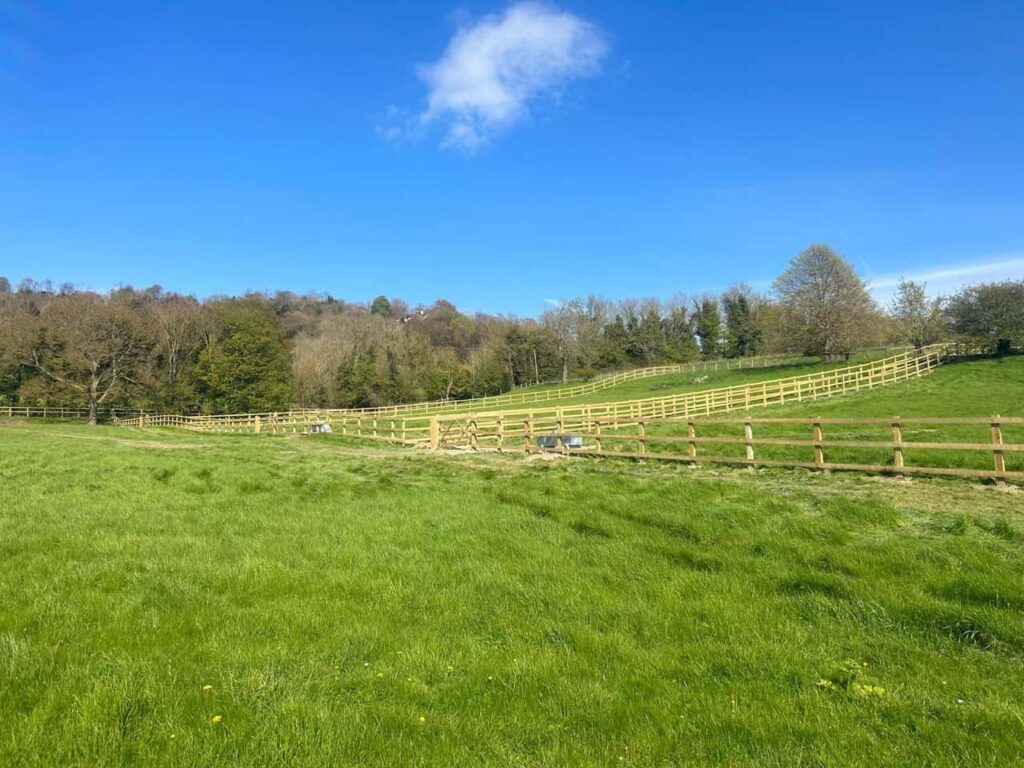
Are there any specific considerations for installing post and rail fencing on slopes or uneven terrain?
Installing post and rail fencing on slopes or uneven terrain requires additional considerations to ensure the fence is aligned correctly, stable, and is visually appealing. Here are some specific considerations for such installations:
Survey the Terrain: Before installing the fence, we’ll survey the slope or uneven terrain to understand its contours and variations. This will help determine the best placement of posts and rails to accommodate the changes in elevation and maintain a visually consistent appearance.
Adjust Post Heights: In sloped or uneven areas, the posts should be adjusted in height to account for the changing terrain. The posts on the lower side of the slope should be longer to ensure that the rails are level across the entire fence. This may involve cutting the posts at different lengths to match the contour of the land.
Step or Stepped Design: A step or stepped design may be necessary if the slope is significant. This approach divides the fence into sections, each positioned at different heights to follow the slope. The rails will step down or up with the contour of the land, resulting in a stepped appearance. This allows the fence to maintain a level top rail while following the terrain.
Bracing and Support: Additional bracing and support may be required on slopes or uneven terrain to ensure the fence’s stability. This can involve diagonal braces or anchoring techniques to reinforce the posts and prevent shifting or leaning.
Taking these considerations into account will help ensure that the post and rail fencing is installed correctly on slopes or uneven terrain, providing a stable and aesthetically pleasing boundary that follows the natural contours of the land.
Looking for post and rail fencing near me?
We can help. Here are just some of the areas we offer post and rail fencing installations and repairs:
